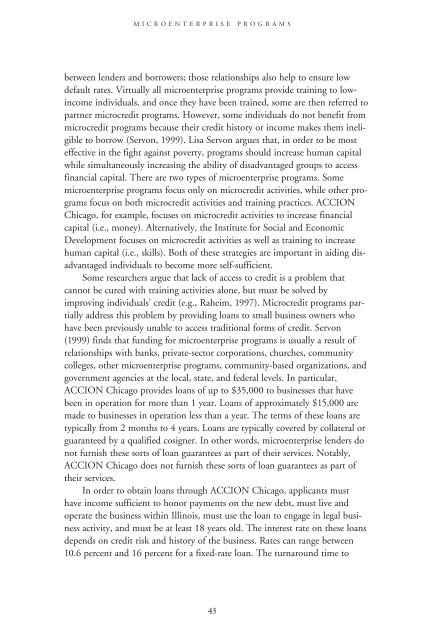2004 - School of Social Service Administration - University of Chicago
2004 - School of Social Service Administration - University of Chicago
2004 - School of Social Service Administration - University of Chicago
You also want an ePaper? Increase the reach of your titles
YUMPU automatically turns print PDFs into web optimized ePapers that Google loves.
MICROENTERPRISE PROGRAMS<br />
between lenders and borrowers; those relationships also help to ensure low<br />
default rates. Virtually all microenterprise programs provide training to lowincome<br />
individuals, and once they have been trained, some are then referred to<br />
partner microcredit programs. However, some individuals do not benefit from<br />
microcredit programs because their credit history or income makes them ineligible<br />
to borrow (Servon, 1999). Lisa Servon argues that, in order to be most<br />
effective in the fight against poverty, programs should increase human capital<br />
while simultaneously increasing the ability <strong>of</strong> disadvantaged groups to access<br />
financial capital. There are two types <strong>of</strong> microenterprise programs. Some<br />
microenterprise programs focus only on microcredit activities, while other programs<br />
focus on both microcredit activities and training practices. ACCION<br />
<strong>Chicago</strong>, for example, focuses on microcredit activities to increase financial<br />
capital (i.e., money). Alternatively, the Institute for <strong>Social</strong> and Economic<br />
Development focuses on microcredit activities as well as training to increase<br />
human capital (i.e., skills). Both <strong>of</strong> these strategies are important in aiding disadvantaged<br />
individuals to become more self-sufficient.<br />
Some researchers argue that lack <strong>of</strong> access to credit is a problem that<br />
cannot be cured with training activities alone, but must be solved by<br />
improving individuals’ credit (e.g., Raheim, 1997). Microcredit programs partially<br />
address this problem by providing loans to small business owners who<br />
have been previously unable to access traditional forms <strong>of</strong> credit. Servon<br />
(1999) finds that funding for microenterprise programs is usually a result <strong>of</strong><br />
relationships with banks, private-sector corporations, churches, community<br />
colleges, other microenterprise programs, community-based organizations, and<br />
government agencies at the local, state, and federal levels. In particular,<br />
ACCION <strong>Chicago</strong> provides loans <strong>of</strong> up to $35,000 to businesses that have<br />
been in operation for more than 1 year. Loans <strong>of</strong> approximately $15,000 are<br />
made to businesses in operation less than a year. The terms <strong>of</strong> these loans are<br />
typically from 2 months to 4 years. Loans are typically covered by collateral or<br />
guaranteed by a qualified cosigner. In other words, microenterprise lenders do<br />
not furnish these sorts <strong>of</strong> loan guarantees as part <strong>of</strong> their services. Notably,<br />
ACCION <strong>Chicago</strong> does not furnish these sorts <strong>of</strong> loan guarantees as part <strong>of</strong><br />
their services.<br />
In order to obtain loans through ACCION <strong>Chicago</strong>, applicants must<br />
have income sufficient to honor payments on the new debt, must live and<br />
operate the business within Illinois, must use the loan to engage in legal business<br />
activity, and must be at least 18 years old. The interest rate on these loans<br />
depends on credit risk and history <strong>of</strong> the business. Rates can range between<br />
10.6 percent and 16 percent for a fixed-rate loan. The turnaround time to<br />
43
















